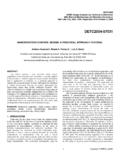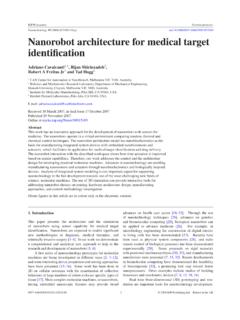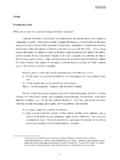Transcription of NANOROBOTIC CHALLENGES IN BIOMEDICAL …
1 IEEE ICECS Int l Conf. on Electronics, Circuits and Systems Tel-Aviv, Israel, December 2004 NANOROBOTIC CHALLENGES IN BIOMEDICAL applications , design AND CONTROL Adriano Cavalcanti1, Lior Rosen2, Luiz C. Kretly1, Moshe Rosenfeld3, Shmuel Einav2 1 Electrical and Computer Eng. School, Unicamp, Campinas, Brazil 2 Dept. of BIOMEDICAL Eng., 3 Dept. of Fluid Mechanics, Tel Aviv University, Tel Aviv, Israel ABSTRACT Ongoing developments in molecular fabrication, computation, sensors and motors will enable the manufacturing of nanorobots - nanoscale biomolecular machine systems.
2 The present work constitutes a novel simulation approach, intended to be a platform for the design and research of nanorobots control. The simulation approach involves a combined and multi-scale view of the scenario. Fluid dynamics numerical simulation is used to construct the NANOROBOTIC environment, and an additional simulation models nanorobot sensing, control and behavior. We discuss some of the most promising possibilities for nanorobotics applications in BIOMEDICAL problems, paying a special attention to a stenosed coronary artery case.
3 Keywords: BIOMEDICAL computing, control systems, coronary stenosis, mobile robots, nanomedicine, nanorobots, nanotechnology. 1. INTRODUCTION This paper describes a study for developing nanorobotics control design to deal with many of the challenging problems in BIOMEDICAL applications . The problem we consider here is mainly focused on nanomedicine [10], where the BIOMEDICAL interventions and manipulations are automatically performed by nanorobots. While these nanorobots cannot be fabricated yet, theoretical and simulation studies defining design strategies, capabilities and limitations, will supply better comprehension of nanorobots behavior and the nanoworld [4][5].
4 In recent years, the potential of a new interdisciplinary field of science has motivated many governments to devote significant resources to nanotechnology [16][22]. The National Science Foundation has launched a program in Scientific Visualization [15], in part to harness supercomputers in picturing the nanoworld. A 1 trillion US$ market consisting of devices and systems with some embedded nanotechnology is projected by 2015 [8]. The research firm DisplaySearch predicts rapid market growth of organic light emitting diodes, from 84 million US$ in 2002 to billion US$ in 2007 [14].
5 A first series of commercial nanoproducts is foreseeable by 2007 [11]. In order to build electronics at nanoscales, firms are collaborating to produce new nanoproducts. Such companies include IBM, PARC, Hewlett Packard, Bell Laboratories, and Intel Corp., to name a few [14]. Recent developments in the field of biomolecular computing [1] have demonstrated positively the feasibility of processing logic tasks by bio-computers [12], which is a promising first step to enable future nanoprocessors with increased complexity.
6 Studies targeted at building biosensors [21] and nano-kinetic devices [20], required to enable nanorobotics operation and locomotion, have been advancing recently as well. A first generation of nanorobots is likely to emerge within the next five to ten years [17]. 2. MEDICAL NANOROBOTIC applications applications of nanorobots are expected to provide remarkable possibilities. An interesting utilization of nanorobots may be their attachment to transmigrating inflammatory cells or white blood cells, to reach inflamed tissues and assist in their healing process [3].
7 Nanorobots will be applied in chemotherapy to combat cancer through precise chemical dosage administration, and a similar approach could be taken to enable nanorobots to deliver anti-HIV drugs. Such drug-delivery nanorobots have been termed pharmacytes by Freitas [10]. Nanorobots could be used to process specific chemical reactions in the human body as ancillary devices for injured organs. Monitoring and controlling nutrient concentrations in the human body [5], including glucose levels in diabetic patients will be a possible application of medical nanorobots.
8 Nanorobots might be used to seek and break kidney stones. Another important possible feature of medical nanorobots will be the capability to locate atherosclerotic lesions in stenosed blood vessels, particularly in the coronary circulation, and treat them either mechanically, chemically or pharmacologically [10]. The coronary arteries are one of the most common sites for the localization of atherosclerotic plaques, although they could be found in other regions as well. IEEE ICECS Int l Conf. on Electronics, Circuits and Systems Tel-Aviv, Israel, December 2004 Figure 1: Schematic view of molecular identification by chemical signals through nanorobot sensors.
9 Figure 2: View of the NCD simulator workspace showing the vessel wall, red blood cells and nanorobots. 3. PROPOSED design Nanorobot manufacturing will undoubtedly require development of breakthrough technologies in fabrication, computation, sensing and manipulation. Researching the requirements, anticipated behavior and performance, and design of control strategies will require simulation tools which will both model foreseeable nanoscale technologies, and in turn influence the development of the same technologies.
10 The simulation approach presented in this paper consists of adopting a multi-scale view of the scenario, which is comprised of: macroscale physical morphology and physiological flow patterns, and on the nanoscale, the nanorobot fluid dynamics, orientation and drive mechanisms, sensing and control. Two simulations are used to achieve the most faithful modeling of nanorobots behavior in a real physical context. These simulations (NCD for the micro level, CFD for the macro level) are described in the next paragraphs, starting with assumptions made for the nanorobot simulation.









